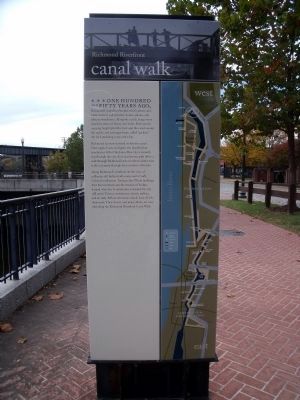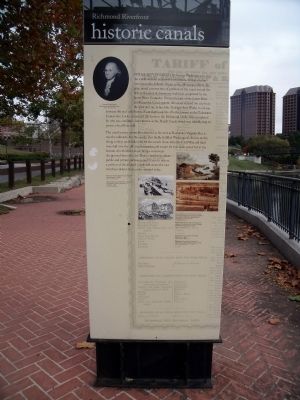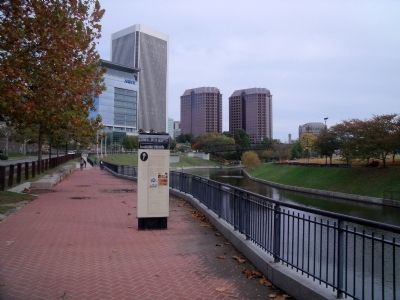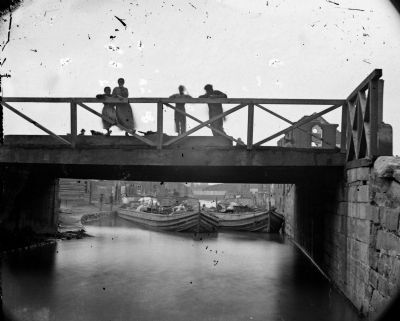Gambles Hill in Richmond, Virginia — The American South (Mid-Atlantic)
Canal Walk / Historic Canals
Richmond Riverfront
First envisioned by George Washington in 1774, the canals were to be part of a continuous transportation route from the Atlantic Ocean to the Mississippi River. By 1789, initial construction of portions of the canal around the falls to the west of downtown had been completed by the James River Canal Company. Ultimately part of the James River and Kanawha Canal system, this canal entered the city from the west and ran behind the Tredegar Iron Works to a basin between 8th and 11th Streets. From there, a series of locks, known as the Tidewater Connection Locks, connected the basin to the Richmond Dock. Also completed by 1789 was a millrace, later known as the Haxall Canal, which was initially dug to power a local flour mill.
The canal system eventually extended as far west as Buchanan, Virginia. But it was the railroads, not the canals, that finally fulfilled Washington’s dream, and in doing so they spelled the end for the canals. Soon after the Civil War, rail lines were laid over the old canal towpaths, and except for two locks preserved at the bottom of 12th Street, these unique waterways disappeared from the city. That is until 1995, when public and private partners joined forces to restore a portion of the original canals and create the new riverfront district that can be enjoyed today.
historic canals
One hundred and fifty years ago, Richmond’s waterfront bustled with business and trade, workers and travelers, hotels, saloons, and tobacco warehouses. Along the canals, barges were towed by teams of horses and mules. Batteaux for carrying freight plied the river and the canal around the rapids, and passenger boats, called “packets,” left for Lynchburg every other day.
Richmond has now restored its historic canals. Once again, boats can bypass the beautiful but treacherous falls of the James River for a leisurely trip through the city. And a pedestrian path offers a walk through Richmond’s new riverfront district that is also a journey through four centuries of history.
Along Richmond’s riverfront are sites of millennia-old Indian trade routes and of early Colonial settlements. Tredegar Iron Works buildings have been restored, and the remains of bridges burned when the Confederates evacuated the city still stand. Tobacco warehouses, electric trolleys, and an early African American church have all left their mark. Their stories, and many others, are now told along the Richmond Riverfront Canal Walk.
Erected by Richmond Riverfront Canal Walk.
Topics. This historical marker is listed in these topic lists: Bridges & Viaducts • Industry & Commerce • Railroads & Streetcars • Waterways & Vessels. A significant historical year for this entry is 1774.
Location. 37° 32.1′ N, 77° 26.663′ W. Marker is in Richmond, Virginia. It is in Gambles Hill. Marker can be reached from Tredegar Street near South 5th Street. This marker is on Richmond's Canal Walk along the Haxall Canal at Brown's Island. Touch for map. Marker is in this post office area: Richmond VA 23219, United States of America. Touch for directions.
Other nearby markers. At least 8 other markers are within walking distance of this marker. Tredegar Iron Works (within shouting distance of this marker); Haxall Headgates (within shouting distance of this marker); Joseph Reid Anderson (within shouting distance of this marker); a different marker also named Tredegar Iron Works (within shouting distance of this marker); Potterfield Bridge (within shouting distance of this marker); The Gun Foundry (within shouting distance of this marker); Belle Isle (about 300 feet away, measured in a direct line); a different marker also named The Tredegar Iron Works (about 300 feet away). Touch for a list and map of all markers in Richmond.
More about this marker. On the right side of the canal walk panel is a map of the Canal Walk.
On the upper left is a portrait entitled “George Washington Painting by Rembrandt Peale.” Courtesy of the Valentine Museum.
Right, top: Railroad ties being laid over the canal towpath, c. 1880. Courtesy of the Valentine Museum.
Right, below: Boats along the James River and Kanawha Canal. Sketch by J. R. Hamilton, 1865. Courtesy of the Valentine Museum.
Top: The James River and Kanawha Canal entering Richmond from the west. Aquatint of an engraving by W. J. Bennett from a painting by G. Cooke, 1834. Courtesy of the Valentine Museum.
Above: View of the canal running past the Virginia Manufactory of Arms and Tredegar Iron Works, Edward Beyer, 1857. Courtesy of the Valentine Museum.
Background, top: People overlooking the canal, c. 1865. Courtesy of the Library of Congress
Background: Broadside issued by the James River and Kanawha Company, 1844. Courtesy of the Library of Virginia
This marker is replicated along the Canal Walk.
Also see . . .
1. Riverfront Canal Cruises in Richmond. Venture Richmond (Submitted on October 29, 2009.)
2. James River and Kanawha Canal Historic District. National Register of Historic Places (Submitted on October 29, 2009.)
Credits. This page was last revised on February 1, 2023. It was originally submitted on October 29, 2009, by Bernard Fisher of Richmond, Virginia. This page has been viewed 1,379 times since then and 51 times this year. Photos: 1, 2, 3. submitted on October 29, 2009, by Bernard Fisher of Richmond, Virginia. 4. submitted on November 1, 2009, by Bernard Fisher of Richmond, Virginia.



